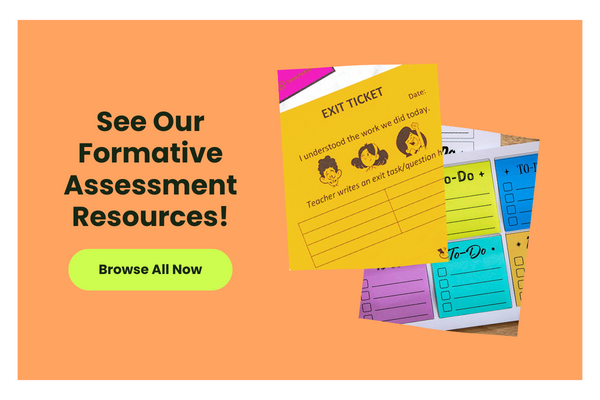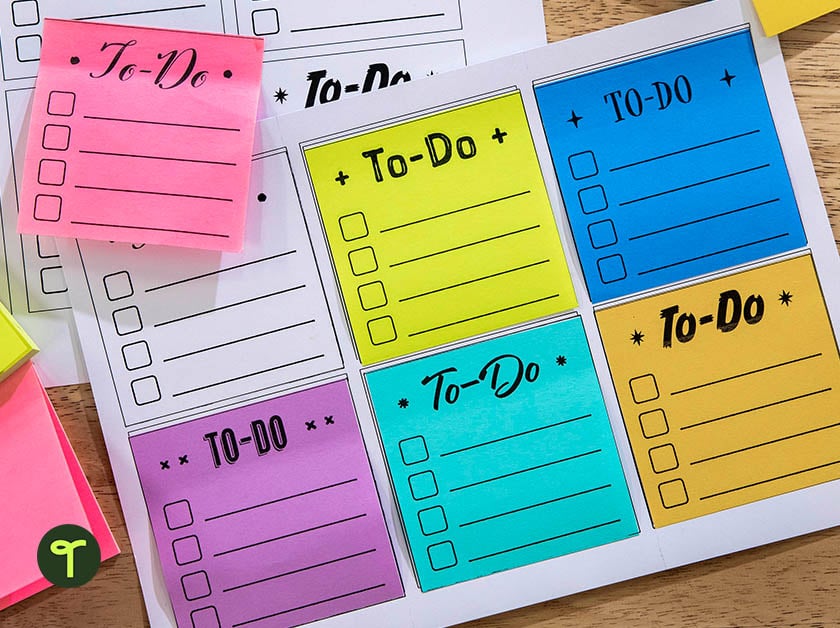Formative assessments may be low stakes for students, but this method of monitoring student learning plays a crucial role in overall student progress monitoring throughout the school year. Are you looking or fresh formative assessment examples to use in your classroom that will give you the information you need but also keep your students engaged?
You’ve landed in the right place!
The teachers on the Teach Starter team have gathered this list of fun and engaging formative assessment examples and ideas to help you make sense of your students’ understanding and quickly identify any learning gaps. We’ve included assessment ideas that will only take a few minutes, as well as some that are a bit more in-depth.
Read on for our favorite ideas, plus links to some of our favorite printable resources that you can add to your classroom routines right away.
Formative Assessment Examples for Teachers
Formative assessment involves a variety of strategies — everything from observation to questioning to discussion and feedback are all used to assess student understanding and progress. You can use the information gathered from these assessments to adjust your teaching methods and provide targeted support to individual students. The list of ideas and examples you’re about to read come from the members on our teacher team and span a variety of grade levels.
We realize not every idea on this list will work for every teacher (or every student for that matter), so feel free to pick and choose the ideas that will work best in your classroom.
Jumping Letter Recognition
Let’s start off with a formative assessment example for primary teachers that doubles as both a letter recognition assessment and an active activity to get some of those wiggles out.
Grab the painter’s tape, and tape letters to your classroom floor! Students line up, and you call out a letter for students to “jump” to.
Hands Up Fun
Need a quick and easy formative assessment that won’t take up a lot of time? Instead of having students raise their hands if they feel they understood the lesson or need help, make things a little more fun with hand signals.
A fist in the air could be “I need more practice” or using the “hook ’em horns” signal in the air could mean “I mostly understand and could show a classmate.”
Create a Comic Strip
Bring the fun of superheroes and villains into your formative assessments by assigning students to create a comic strip that details what they’ve just learned! This allows students to demonstrate their understanding in a visually engaging and creative way.
[resource:2668938] [resource:2658586]
Thumbs Have It
Another simple assessment idea is to have students use their thumbs to indicate their understanding. Thumbs up is “I’ve got it,” a thumb to the side could be “so-so” or “I’ve sort of got it,” and a thumbs down can indicate that students need more practice or help.
Emoji Assessment
Kids love emojis, and they’re a perfect way to gauge how well students feel they’ve grasped a concept. Download free emoji self-assessment cards for the entire class, and instruct students to hold up the emoji that best fits how they’re feeling! Alternately, students can leave their emoji cards on their desks while performing independent work, so you know which students need help.
Tweet Tweet
Elementary students may not be on Twitter, but that doesn’t mean you can’t take a nod from the social media platform to make formative assessments more fun for students. Challenge them to sum up the lesson in 280 characters or less on a sticky note, or ask them to create three hashtags that describe the day’s lesson. The sticky notes can be posted on a parking lot on your wall.
Exit Tickets
Exit tickets are a classic formative assessment example and for good reason! They’re an easy way to collect student feedback, and you can make them as simple or as detailed as you want!
Explore a collection of exit tickets already created and ready to print!
Hit the Target
Set up a target on your classroom wall (this printable target is available as a PDF or in Word for editing!), and ask students to evaluate how well they understand a lesson by placing a sticky note with their name on the target. If they feel they can explain the concept to a classmate, for example, their sticky should go on the bullseye! Need help? Their sticky goes on the outer ring.
Spot the Error
Present your class with a list of “facts” from the lesson, including some common misconceptions or points of confusion related to your lesson. Ask your students to “spot the error” to determine if they’re caught up in those confusion points.
Doodle Notes
Doodling has been proven to improve memory recall and help visual learners. So lean into the benefits for your formative assessments! Allow students to draw a picture to show you what they’ve learned, rather than requiring them to write something out.
Download a set of printable doodle notes for your math classes!
Two Truths and a Lie
A similar version to the spot the error formative assessment example, you can present your class with two truths and a lie about the subject, challenging students to activate prior knowledge to identify the lie.
You can also flip this idea — ask students to come up with two truths of their own, plus a lie about the concept you’ve just taught. Give students a few minutes to think of their statements, and then have them share them with the class. Ask students to guess which statement is the lie. Encourage them to explain their reasoning and provide evidence to support their answers.
Sentence. Phrase. Word.
Have your students write down a sentence that summarizes the lesson. Next, they should circle the most important phrase in the sentence, and draw a line beneath an important word.
Solve 3
After a math lesson, write out three problems on the whiteboard, and ask students to solve them on a sticky note. Students should write their names on their sticky notes and hand them in so you can read through and evaluate how well they did. This is a great way to determine your intervention groups.
Want to pre-design your sticky notes? Download a template for printing your own sticky notes!
Write it on the Whiteboard
It’s simple, we know, but if your students have individual whiteboards, this is an effective formative assessment idea. Similar to using hand signals, assign a value to numbers or letters such as “A means I don’t understand,” and “Be means I almost have it.” Direct students to write the letter (or number) on their whiteboards and hold them up.
Think, Pair, Share
Getting to talk to a friend during class is always a hit with students, and think, pair, share exercises make great formative assessments too. All you need to do is walk around, listen in, and take a quick anecdotal record to identify students showing mastery.
Concept Map
Direct students to walk you through their thoughts about the lesson with a concept map. Students can answer questions like “What is it?” or “What are some examples?” Concept maps work extremely well as formative assessments and activities during vocabulary instruction.
[resource:4642554] [resource:4642562]
Headline It
This is another quick and easy formative assessment idea. If your students were going to write a newspaper article about the lesson, what would their headline be?
Wanted Poster
We saved one of our favorite formative assessment examples for last! Direct students to create a wanted poster for anything from a historical figure they’re learning about in social studies to a numeral in math class!
Banner image via Shutterstock/Monkey Business Images









Comments